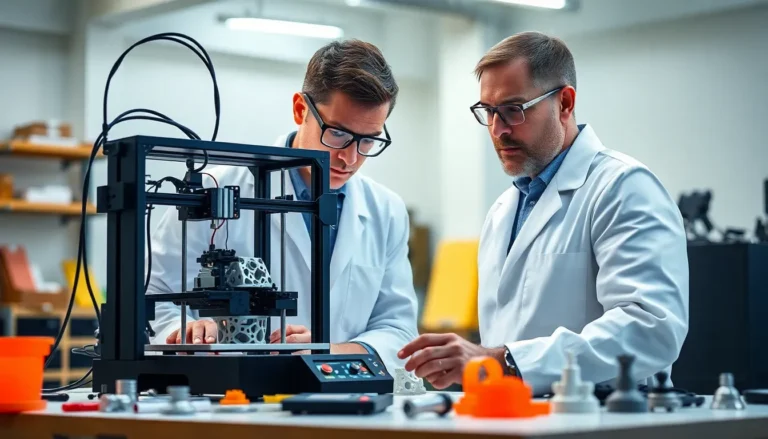Imagine a world where your wallet is as obsolete as a flip phone. Welcome to the era of biometric payments, where your unique traits—like fingerprints, facial recognition, or even your heartbeat—unlock the door to a seamless shopping experience. Gone are the days of fumbling for cash or wondering if your credit card is still in your other pants.
Biometric payments are not just a futuristic fantasy; they’re reshaping how we buy and sell. With security that’s tighter than your grandma’s hug and convenience that’s as easy as a Sunday morning, this payment method is making waves in the financial ocean. So why stick to outdated methods when you can pay with a smile—or a wink? Dive into the world of biometric payments and discover how technology is making transactions not just secure, but also a little more fun.
Table of Contents
ToggleOverview of Biometric Payments
Biometric payments represent a revolutionary approach to transaction security. Utilizing unique personal traits, these systems authenticate users through fingerprints, facial recognition, and even heartbeats. Enhanced security accompanies convenience, easily surpassing traditional payment methods like cash and credit cards.
Many consumers now favor this technology due to its speed and efficiency. Studies show that 70% of users prefer biometric payments for daily transactions. Privacy concerns, while significant, often diminish when users understand the encrypted nature of biometric data. Unlike conventional systems, biometric verification does not require sensitive information, reducing the risk of fraud and theft.
This payment method offers usability in various environments. Retailers adopt biometric systems at checkout points, allowing for swift transactions. Mobile wallets incorporate biometric authentication, enabling users to make purchases seamlessly from their smartphones. Banks introduce biometric verification for secure online banking, enhancing user trust.
Adoption rates continue to rise as technology evolves. With advancements in machine learning and artificial intelligence, recognition accuracy improves, making this system more reliable. Many industry experts predict that biometric payments will dominate the landscape in the next decade. Organizations deploying these solutions experience a noticeable reduction in transaction times, contributing to greater customer satisfaction.
Biometric payments illustrate a significant shift in consumer behavior. They signify a departure from outdated practices and move toward a more secure, efficient future in commerce. As technology progresses, users can expect an increase in personalization and user-friendly interfaces, further solidifying biometric payments as a preferred choice.
Types of Biometric Payments

Biometric payments encompass various methods that utilize unique physical characteristics for transactions. Key types include fingerprint recognition, facial recognition, and iris scanning, each enhancing security and convenience.
Fingerprint Recognition
Fingerprint recognition stands as one of the most common biometric payment methods. This technology analyzes the unique patterns, ridges, and minutiae on a person’s fingertip. Many devices, including smartphones and point-of-sale systems, support fingerprint scanners. Users benefit from fast transactions, as unlocking a device or authorizing payments takes mere seconds. In surveys, over 65% of consumers feel comfortable using fingerprints for payments, citing convenience and security as major advantages.
Facial Recognition
Facial recognition technology utilizes algorithms to analyze facial features, converting them into unique data points for verification. This method has gained traction in mobile wallets and point-of-sale systems, allowing users to complete transactions simply by looking at a camera. Many report that facial recognition offers greater speed when compared to traditional payment methods. According to recent research, nearly 60% of consumers prefer using their faces to make payments, recognizing the efficiency and touchless nature of the process.
Iris Scanning
Iris scanning employs high-resolution cameras to capture the intricate patterns in the iris. This method stands out due to its high accuracy and low false rejection rates, making it an appealing option for secure transactions. Many banks and financial institutions are beginning to integrate iris scanning into their services, reinforcing security measures. Statistics show that the adoption rate for iris-based payments is steadily increasing, with projections indicating a rise in usage as users seek advanced security solutions.
Advantages of Biometric Payments
Biometric payments offer notable benefits, primarily enhanced security and improved user experience. These factors contribute to the rising popularity of this payment method among consumers.
Enhanced Security
Biometric payments prioritize security through unique identifiers. Fingerprints, facial recognition, and iris scans create personal authentication layers, making unauthorized access daunting. Data suggests that biometric methods significantly reduce the risk of fraud, offering peace of mind to users. More than 70% of consumers express confidence in biometric security features. Users appreciate the encryption processes protecting their biometric data, which further alleviates privacy concerns. The combination of advanced technologies and unique user characteristics ensures secure transactions, creating a safer shopping environment. As adoption rates grow, so does the assurance of maintaining financial security through biometrics.
Improved User Experience
Convenience plays a crucial role in enhancing the user experience with biometric payments. Speedy transactions eliminate the lengthy wait times often associated with traditional payment methods. Studies reveal that nearly 60% of users prefer using facial recognition due to its seamless and touchless approach. Fingerprint recognition offers similar efficiency, allowing users to complete transactions quickly. Users find that biometric payments result in fewer errors, reducing the likelihood of declined transactions. Positive experiences lead to increased satisfaction, encouraging users to embrace this technology. Overall, biometric payments streamline the purchasing process, making everyday transactions more enjoyable and efficient.
Challenges and Concerns
Biometric payments present several challenges and concerns that merit attention.
Privacy Issues
Privacy remains a significant concern for many consumers. Users often question how biometric data is stored and used. Studies indicate that privacy worries can diminish when individuals understand encryption protocols protecting their data. Approximately 70% of users express confidence in the security measures surrounding biometric payments. Despite this, concerns about potential unauthorized access and misuse of personal data persist. Awareness about data breaches may deter others from adopting this technology, underscoring the need for clear communication from providers about their data handling practices.
Technological Limitations
Technological limitations also pose challenges for biometric payments. Not all devices support advanced biometric authentication features, restricting accessibility for many users. Variability in the accuracy of biometric systems can lead to false rejections or successful impersonations. For instance, fingerprint sensors can struggle with dirt or moisture, causing inconvenience during transactions. Moreover, environments with poor lighting can negatively impact facial recognition software performance. As technology advances, ongoing improvements will be crucial to enhancing reliability and user trust in biometric payment methods.
Future of Biometric Payments
Biometric payments continue to evolve, shaping the future of transactions with innovative technology. Enhanced security and user convenience contribute significantly to this trend.
Trends to Watch
Increased adoption of biometric payment methods occurs across various sectors. Retail environments implement fingerprint and facial recognition systems at checkout points, enhancing speed and security. Mobile wallets integrate biometric technology, allowing seamless transactions on-the-go. Notably, around 70% of users express a clear preference for these methods, highlighting the shift in consumer behavior. Financial institutions also leverage biometric authentication for secure online banking. Continued advancements in artificial intelligence improve accuracy and reliability as industry experts forecast biometric payments dominating the landscape in the next decade.
Potential Developments
Integration of advanced biometric technologies may push boundaries of user experience. Contactless systems will likely become more common, emphasizing convenience in daily transactions. Enhanced multifactor authentication involving biometrics could emerge, offering layered security beyond traditional methods. Additionally, innovative applications of iris scanning and voice recognition may gain traction. As organizations focus on consumer trust, transparent data management practices will likely become essential. Solutions addressing privacy concerns surrounding biometric data storage may emerge, leading to increased adoption. Overall, these developments indicate a promising future for biometric payments, aligning with consumer demands for security and efficiency.
Biometric payments are set to redefine the way consumers engage in transactions. With their focus on security and convenience, these systems are quickly gaining traction across various sectors. As technology advances, the accuracy and reliability of biometric authentication will only improve, fostering greater consumer trust.
While privacy concerns remain, ongoing transparency and robust data management practices will help alleviate fears, paving the way for broader adoption. The future of commerce looks promising with biometric payments leading the charge towards a more secure and efficient shopping experience. Embracing this innovative payment method could enhance not just security but also the overall enjoyment of transactions.



